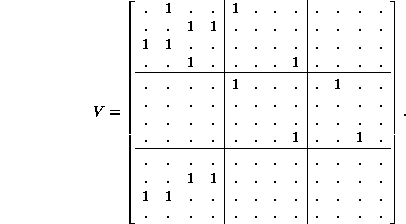Rule 126
To illustrate the use of the subset diagram, consider the automaton for ![]() Rule 126:
Rule 126:
.1em
![]()
In other words, all neighborhoods evolve into ones with the exception of 111 and the
quiescent neighborhood 000, which evolve into zeroes. The de Bruijn diagram for this rule
is ![]() , which has the symbolic variant (dots
represent the null word
, which has the symbolic variant (dots
represent the null word ![]() ):
):
0.50em


Figure 13: Subset diagram for Rule 126.
Since the nodes A=00, C=01, D=10, and F=11 are linked by
the symbols 0 and 1, the subset diagram can be constructed. It actually has ![]() nodes for the sixteen subsets, but to save space we
show only the part connected to the full subset (
nodes for the sixteen subsets, but to save space we
show only the part connected to the full subset (![]() is the empty set). First, note the destination of each arrow leaving individual nodes:
is the empty set). First, note the destination of each arrow leaving individual nodes:

Then, form vectors whose elements are the tail nodes and whose components are indexed by the head nodes; an element is null if there is no incoming link from any node.

This structure is actually the vector subset diagram; the scalar subset diagram arises by enumerating the non-null indices (we don't care how many incoming arrows there are nor where they originate, as long as there is at least one):

its topological matrix, having indexed the subsets in the order shown, is S=a+b according to
0.50em

The matrix is upper triangular, because the null set is linked only to itself. Only the
![]() submatrix in the upper left hand corner is
really necessary. The 2 in the lower right corner is not strictly required, attesting only
to the fact that no path from the null set has anywhere else to go, thereby
conserving the uniform row sum.
submatrix in the upper left hand corner is
really necessary. The 2 in the lower right corner is not strictly required, attesting only
to the fact that no path from the null set has anywhere else to go, thereby
conserving the uniform row sum.
Finally, the topological matrix of the vector subset diagram is

Harold V. McIntosh
E-mail:mcintosh@servidor.unam.mx